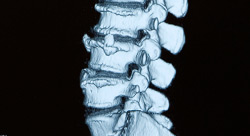Next-Generation Disc Prosthesis Designed in Mathematica
|
Challenge Investigate improved spinal disc replacement solutions. |
Solution Explore a new prosthetic design process using Mathematica. |

Imaginary balloon inflated between vertebrae
|
|
Benefits
|
The Mathematica Edge
|
About 15 to 20 percent of all people live with chronic back pain. With the increasing success of hip and knee joint replacements, researchers hope to achieve similar results for back ailments with an intervertebral disc replacement for the spine.
The Eindhoven University of Technology and the Netherlands Organization for Applied Research have developed new algorithms and a complete workflow in Mathematica to build customized endplates for disc prostheses. Proper fixation of the disc to the vertebrae is of great importance to patient outcomes, but current prostheses are more or less of a one-size-fits-all design. Imperfect alignment often leads to complications such as increased pressure on the spinal column, excessive wear, and other difficulties.
Using modern 3D MRI and CT scans, the exact shape for a customized disc can be determined without any surgery. This is made possible by a segmentation technique that is both more accurate and easier to understand than other methods. Imagine a small balloon being inflatedbetween two spinal vertebrae until it is perfectly meshed against the vertebral surfaces. Those contours could then be used to model the geometry of the needed prosthesis.
Scan images in DICOM format are imported into Mathematica and enhanced as needed, followed by a three-dimensional fit using a "balloon" algorithm developed in Mathematica. The results are exported in STL format directly to a CNC machine, which creates individual conformal endplates that can be fixed to the vertebral surfaces. Additional research into other aspects of the prosthesis—such as creating a flexible joint, the endplate material, and biocompatible coatings—is ongoing.
Researchers eventually hope to make this technique and the specialized, open-source Mathematica add-on that enables it available to the broader medical community. Other possible applications of this method include the segmenting the shape of the brain, ventricles, bones, teeth, or non-physiological objects.
Get started with Wolfram technologies, or work with us to apply computational expertise to your projects.
Questions? Comments? Get in touch: 1-800-WOLFRAM, or email us »























